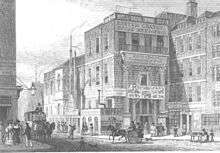Cecil House
Cecil House refers to two historical mansions on The Strand, London, in the vicinity of the Savoy. The first was a 16th-century house on the north side, where the Strand Palace Hotel now stands. The second was built in the early 17th century on the south side nearly opposite, where Shell Mex House stands today.
Exeter House

The first, also called Exeter House or Burghley House, was on the north side of the Strand; it was built in the 16th century by Lord Burghley as an expansion of an existing house;[lower-alpha 1] Cecil moved his London residence there in 1560, and Queen Elizabeth I of England supped with him there, in July 1561, "before my house was fully finished", Cecil recorded in his diary, calling the place "my rude new cottage."[1] When Cecil was created Lord Burghley in 1571, this London seat became known as Burghley House. In fact it was a symmetrical double-courtyard brick house of three storeys, with four-storey corner turrets. A central entrance led from The Strand into the front court.[lower-alpha 2] At its garden front, with a central bay window and corner turrets, the house looked over gardens on grounds purchased from the Earl of Bedford and the earl's fields of Covent Garden beyond. The garden included a mount with a spiralling path to its top, a paved tennis court, a bowling alley, and an orchard.[1]
The house became the residence of Burghley's elder son, Thomas Cecil, created Earl of Exeter in 1605; thus, in Wenceslas Hollar's bird's-eye view of London (ca 1658), it is labelled "Exeter House". The structure formed a notch in the north side of The Strand.[lower-alpha 3] It was converted in 1676 into Exeter Exchange and demolished in 1829.[1]
Salisbury House
The second, more commonly known as Salisbury House, was built on the waterfront opposite the existing house, by Lord Burghley's younger son, Robert Cecil, 1st Earl of Salisbury, around the turn of the 17th century. It was divided by his heir, William Cecil, into two parts, of which the lesser was demolished in 1678 to make room for a new residential street, Salisbury Street. The central part of the building was converted to shops and officially renamed the Middle Exchange, though in character, the building was of ill repute, being known as the "Whores' Nest"; this part of the building was finally demolished around 1695, along with the remainder of the house, to make room for a new road named Cecil Street. The site was subsequently used for the Hotel Cecil, named after this house, and is currently occupied by Shell Mex House.
Notes
- ↑ The house, on the site of the rectory of St Clement Danes, was built by Sir Thomas Palmer, disgraced for his support of Lady Jane Grey and executed with John Dudley, 1st Duke of Northumberland in 1553.[1]
- ↑ A coloured plan of the house and garden as it was ca 1562–67, discovered in the muniment room, Burghley House, in 1999 (Burghley MS M358), provided the first detailed architectural information: "it is also the earliest representation of any English garden".[1]
- ↑ Seen in the engraving above and in John Norden's map of Westminster, London, in Speculum Britanniae, 1593.[1]
References
Further reading
- 'The Strand, southern tributaries - continued', Old and New London Volume 3 (1878), pp. 100–110. URL: . Date accessed: 2 October 2006.
- Salisbury House at London Online
- Smith, John Thomas. The Streets of London (1861), pp. 144–145.
Coordinates: 51°30′37.8″N 0°7′17″W / 51.510500°N 0.12139°W